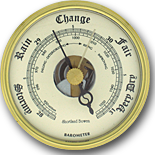 Atmospheric pressure is sometimes defined as the force per unit area exerted against a surface by the weight of air above that surface at
any given point in the Earth's atmosphere. In most circumstances atmospheric pressure is closely approximated by the hydrostatic pressure
caused by the weight of air above the measurement point. Low pressure areas have less atmospheric mass above their location, whereas high
pressure areas have more atmospheric mass above their location. Similarly, as elevation increases there is less overlying atmospheric mass,
so that pressure decreases with increasing elevation. A column of air one square inch in cross-section, measured from sea level to the top
of the atmosphere, would weigh approximately 65.5 newtons (14.7 lbf). The weight of a 1 m2 (11 square feet) column of air would be about
101 kN (10.3 tf).
Atmospheric pressure is sometimes defined as the force per unit area exerted against a surface by the weight of air above that surface at
any given point in the Earth's atmosphere. In most circumstances atmospheric pressure is closely approximated by the hydrostatic pressure
caused by the weight of air above the measurement point. Low pressure areas have less atmospheric mass above their location, whereas high
pressure areas have more atmospheric mass above their location. Similarly, as elevation increases there is less overlying atmospheric mass,
so that pressure decreases with increasing elevation. A column of air one square inch in cross-section, measured from sea level to the top
of the atmosphere, would weigh approximately 65.5 newtons (14.7 lbf). The weight of a 1 m2 (11 square feet) column of air would be about
101 kN (10.3 tf).
The average atmospheric pressure at sea level is 29.92 inches of mercury (inHg) or 1013.25 millibar.
 Atmospheric pressure is sometimes defined as the force per unit area exerted against a surface by the weight of air above that surface at
any given point in the Earth's atmosphere. In most circumstances atmospheric pressure is closely approximated by the hydrostatic pressure
caused by the weight of air above the measurement point. Low pressure areas have less atmospheric mass above their location, whereas high
pressure areas have more atmospheric mass above their location. Similarly, as elevation increases there is less overlying atmospheric mass,
so that pressure decreases with increasing elevation. A column of air one square inch in cross-section, measured from sea level to the top
of the atmosphere, would weigh approximately 65.5 newtons (14.7 lbf). The weight of a 1 m2 (11 square feet) column of air would be about
101 kN (10.3 tf).
Atmospheric pressure is sometimes defined as the force per unit area exerted against a surface by the weight of air above that surface at
any given point in the Earth's atmosphere. In most circumstances atmospheric pressure is closely approximated by the hydrostatic pressure
caused by the weight of air above the measurement point. Low pressure areas have less atmospheric mass above their location, whereas high
pressure areas have more atmospheric mass above their location. Similarly, as elevation increases there is less overlying atmospheric mass,
so that pressure decreases with increasing elevation. A column of air one square inch in cross-section, measured from sea level to the top
of the atmosphere, would weigh approximately 65.5 newtons (14.7 lbf). The weight of a 1 m2 (11 square feet) column of air would be about
101 kN (10.3 tf).